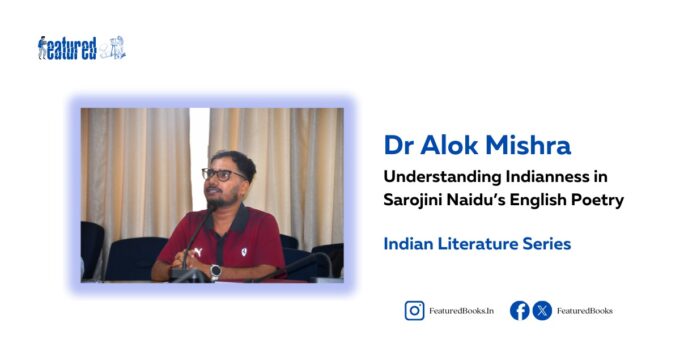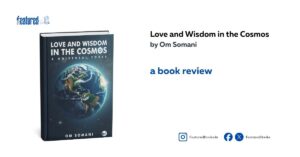“In the hands of Sarojini Naidu, Indianness takes the shape of an inclusive approach to life by Indians, as has been the case for millennia. Expressed in the metaphors of inclusion, acceptance, mutual respect, and co-existence, Naidu’s eventual realisation of her roots – the core of Indian civilisation – came out in her later poems in the form of the oneness of the human soul, oneness with the flow of the universe and non-duality of existence, taking her poetry to its logical heights, above from the surface understanding of her earlier expressions of the Hyderabad Bazaars and worldly beauty.”
Dr Alok Mishra
These are the thoughts of Dr Alok Mishra, who recently earned his PhD by successfully defending his doctoral thesis titled “In Search of Roots: Indianness in Indian English Poetry” on June 27, 2025. When asked how he assesses the poetry of Sarojini Naidu, the first-generation pioneer in Indian English Poetry, he categorically brackets Naidu as “one of the lyrically able poets who could fuse philosophy and rhythm beautifully enough to evoke emotions and thoughts of the readers at the same time”.
Even Sri Aurobindo appreciates Naidu for her “strange power of brilliant colour and exquisite melody” in one of the letters written in 1931 (Letters on Poetry and Art, 446). Anyone with a noble sense of judgment and evaluation would agree with Sri Aurobindo’s assessment. Naidu’s power to mix philosophical ideas in beautifully crafted lines laden with rhythm is simply unmatched. Let us take a look at the lines below:
“Dream yields to dream, strife follows strife,
And Death unweaves the webs of Life.”
(The Golden Threshold 97)
In this straightforward, lyrically rich and contemplative couplet from the poem “To A Buddha Seated on a Lotus,” Naidu presents a profound philosophical truth that Indians have known for ages: through scriptures and simply through the very approach to life, death is no stranger to India. The one who is born has to die. The one who dies comes again via rebirth. The eternal cycle of life and death, and also the higher pursuit of Moksha, finds a reflection in the poems of Sarojini Naidu more often, especially in the latter works, as Dr Alok Mishra points out in his statement quoted at the opening of this article.
Naidu’s poetic craft matured with time. The evolution of her poems, in terms of themes and philosophical depth, is readily apparent to anyone who observes them. Though critics of the day and those from the generation just after independence may dismiss Saorjini’s poetry as mere imitation of the romantic of British poetry, it’d be a case of oversimplification and rather an injustice to the poet who was, perhaps, the first to win the recognition of the British critics as an accomplished poet in English, long before Tagore’s Nobel Prize in literature (M. K. Naik). When asked about the evolution of her poems and her qualities as a poet, Dr Alok Mishra offered an apt assessment:
“Sarojini Naidu began her literary journey with a celebration of the country’s visible beauty. Women with pitchers, the decorated city of Hyderabad, beautiful ladies in Ghunghat and ornaments, vivid streets, and the natural landscape, with occasional acknowledgement of the invisible sustainer behind the things we could see… However, eventually, the Indian consciousness inside her began to express itself. Naidu starts acknowledging the power of time, universal echoes of the unheard voices, the ancient wisdom India possessed on life, death, and the soul-cycle, the solace Indian philosophy offers by acknowledging death as a part of life, and the ultimate surrender to the supreme origin of things around us, something that M. K. Naik calls the “Mystical Self-surrender” by Naidu…”
In Dr. Alok Mishra’s statement, the Indianness in Sarojini Naidu’s poetry is highlighted through her initial portrayal of India’s visible beauty and cultural diversity. Naidu’s early poems celebrate the vivid, tangible aspects of the country—its people, landscapes, and cultural symbols. The image of women with pitchers, the adorned city of Hyderabad, and the vibrant streets are quintessentially Indian motifs that evoke the country’s rich traditions and daily life. Naidu’s use of these images reveals her connection to the sensory and visual beauty of India, emphasising a poetic style grounded in the sensory and aesthetic appeal of the subcontinent. The poems paint India as a land of natural wonders and intricate cultural practices, creating a vibrant and colourful picture for the reader. However, the underlying current of her early work hints at a deeper spiritual and philosophical engagement with the land, which would later mature into a more profound exploration of Indian consciousness.
As Dr. Mishra notes, Naidu’s later poetry reflects a deeper engagement with the philosophical and metaphysical aspects of Indian culture. The poet begins to move beyond mere surface beauty and embraces the spiritual underpinnings of Indian life. Her acknowledgement of time, death, and the soul cycle indicates a growing awareness of India’s ancient wisdom, particularly its philosophical views on life, death, and the eternal cycle of rebirth. Naidu’s reflection on the idea of “Mystical Self-surrender,” as described by M. K. Naik, points to her understanding of the Indian concept of surrender to the divine or supreme being. This surrender, rooted in the Hindu Indian philosophical tradition, offers solace in the face of life’s transient nature. Naidu’s poetry thus shifts from celebrating external beauty to acknowledging a deeper, metaphysical reality, reflecting the spiritual core of Indian philosophy. Through this journey, her poetry becomes an embodiment of the evolving Indian consciousness, integrating the visible with the invisible, the earthly with the divine, and the temporal with the eternal.
To conclude, Sarojini Naidu’s English poetry is marked by Indianness, from the beginning to the end of her poetic career, spanning her active involvement in India’s political landscape both before and after independence. Like her poetic craft, the reflection of Indianness also matures with time. I would recommend getting a good poetry collection with poems by Naidu if anyone wants to understand her poetic craft and evolution as a poet. Below is a link to the recommended book on Amazon India:
Sarojini Naidu Collected Poems and Prose
Article by Alka with special conversational inputs by Dr Alok Mishra, founder of English Literature Education





